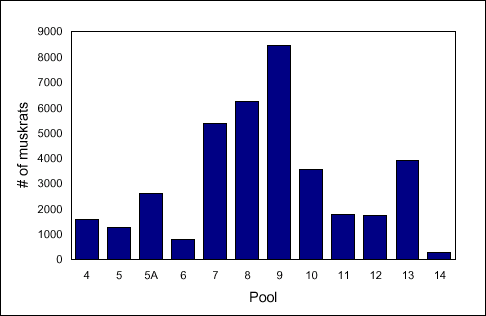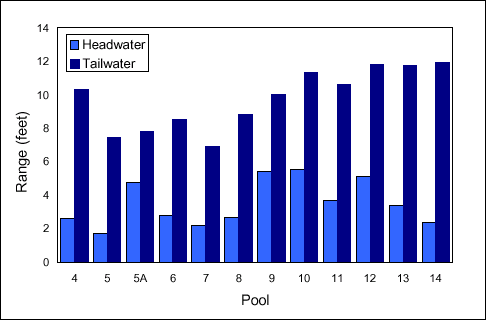|
June 1998 PSR 98-06 Muskrat Harvests, Water Levels, and Aquatic Vegetation on the Upper Mississippi River National Wildlife and Fish Refugeby Joseph H. Wlosinski and Laurie B. Wlosinski |
||
|
Monitoring vegetation and wildlife, and determining the effects of water levels on the ecosystem are identified strategies in the Strategic Plan for the Environmental Management Technical Center’s Long Term Resource Monitoring Program. As part of those strategies, we regressed harvest data for muskrats (Ondatra zibethicus) trapped in the 1990’s, comprising 89% of the fur harvest by numbers, against water level fluctuations and aquatic vegetation on the Upper Mississippi River National Wildlife and Fish Refuge (Refuge). The Refuge extends 261 miles from north of Wabasha, Minnesota, to near Rock Island, Illinois, encompassing most of Pools 4 through 14. The Refuge covers nearly 200,000 acres of mostly open water, bottom land hardwoods, and aquatic vegetation. Recreational trapping has been allowed on the Refuge since 1939. During our six-year study period, for the 1990 and 1992 through 1996 seasons, we examined muskrat harvest data as reported on fur catch reports. We obtained daily water level data from the St. Paul District of the U. S. Army Corps of Engineers, who manage water levels on all pools within the Refuge in order to maintain a 9 ft navigation channel. Aquatic vegetation estimates were obtained from aerial photography taken during the late summer of 1989. Trappers were required to obtain a permit and submit a mandatory yearly fur catch report during the six-year study period. The report included the number of days trapped, pools trapped, and the number of muskrats harvested. Each trapper was allowed a maximum of 40 traps that had to be checked daily. The number of yearly permits issued on the Refuge ranged from 292 to 466. An average of 94% of the trappers having permits returned a fur catch report. Trappers failing to submit a report were not issued a permit for the next trapping season. Of those returning reports, 13% did not trap. |
||
|
||
|
Active Refuge trappers averaged 20.6 days of effort. Muskrat harvest ranged from a low of 30,283 for the 1993-1994 trapping season to a high of 50,010 during the 1994-1995 season. The lowest daily catch per unit effort, 2,062 muskrats, was also reported during the 1994-1995 season. The highest value, 2,955 muskrats per day, was reported for the 1996-1997 season. Although the variability in muskrat harvest was relatively low for the entire Refuge, variability among pools was quite high (Figure 1). The average muskrat harvest from Pool 9 was well over an order of magnitude higher than from Pool 14. Water level fluctuations were calculated for the tailwater and headwater areas for each of the 12 pools for five time periods (i.e., each quarter of the year and for the entire year). The range for each period and standard deviation of daily water levels for each period were the estimators used for water level fluctuations. The average yearly range of water levels at pool headwaters was between 2 and 6 ft (Figure 2). |
||
|
||
|
That variable ranged between 6 and 12 ft in the tailwaters. We used two trapping variables, total muskrat harvest by pool and catch per unit effort (per day) per pool. However, catch per unit effort was confounded because we did not know the number of traps used by each trapper or their target species. The combination of five time periods, 12 pools, two trapping variables, two statistics, and two locations led to 480 linear regressions, each with six data points. The null hypothesis tested for each case was that the harvest of muskrats was not affected by water level fluctuations. Results of the regressions of muskrat harvest versus water levels showed that only 11 out of a possible 480 tests (2.3%) were significant at the alpha = 0.05 level. The few significant relationships were not grouped in any particular time period, pool, trapping variable, statistic, or location. This lead us to the conclusion that water levels, for the most part, did not affect muskrat harvest on the Refuge. Note, however, that it is widely held from numerous other studies that muskrat populations are affected by water level fluctuations. We believe our results do not refute those studies. Other factors that affect muskrat harvest include the length of the trapping season, fur prices both of muskrats and other species, weather conditions, habitat changes, and trapping effort. Although sometimes used as a surrogate for population estimates, harvest may not be a good estimator for muskrat populations. |
||
|
||
|
Regression of muskrat harvest against aquatic vegetation was performed separately and at a coarser scale. We regressed the average number of muskrats trapped per pool over the six-year period against the 1989 vegetation estimates classified as emergents or rooted floating aquatics. The relationship between aquatic vegetation and muskrat harvest was much more positive, with 76% of the harvest being explained by differences in vegetation estimates (Figure 3). The null hypothesis that harvest was not related to vegetation estimates was rejected at the alpha = 0.05 level. We are currently investigating the relationship between vegetation and muskrat harvest on the Refuge at a finer level of resolution. |
||
|
This report is a product of the Long Term Resource Monitoring Program for the Upper Mississippi River System. For further information, contact Dr. Joseph H. Wlosinski Laurie B. Wlosinski Project Status Reports (PSRs) are preliminary documents whose purpose is to provide information on scientific activities. Because PSRs are only subject to internal peer review, they may not be cited. Use of trade names does not imply U.S. Government endorsement of commercial products. All Project Status Reports are accessible through the Upper Midwest Environmental Sciences Center’s website at http://umesc.usgs.gov/reports_publications/psrs/umesc_psr.html |
Page Last Modified: April 17, 2018




